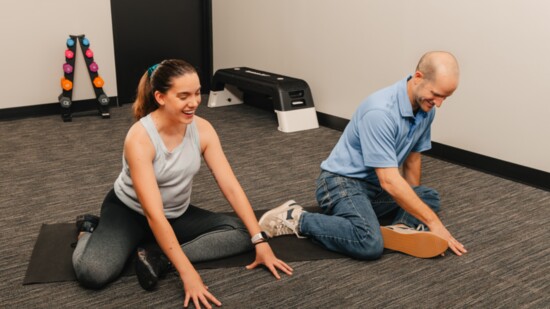A name like R3 Physio begs the question: What exactly are the three R’s? Jason Racca, owner of R3 Physio defines them as being the comprehensive process of the physical therapy services his office provides:
Relief: The first priority is providing pain and discomfort relief to the injured person.
Restore: Restoring the affected area to its state before an injury or decline in functionality by taking a comprehensive approach to the patient’s care.
Refine: Where traditional physical therapy practices would stop once functionality is restored, Jason’s practice prioritizes the patient’s goals and desired results.
According to Jason, most patients don’t realize their potential until they can heal what brought them in to begin with. Once those issues are resolved, patients can ask themselves, “How do I keep going?” to push them toward achieving results that put them above their previous baseline.
“It's not uncommon for patients to find themselves seeking treatment at R3 Physio because of a chronic issue that fails to respond to traditional treatment,” he said of the kind of clients he typically sees. This is because conventional physical therapy treatment is dictated based on a general timeline of where that patient should be and not where they actually are. This can lead to patients either being pushed too hard or even more concerning, not making progress at all and sliding backward from where they began. R3 Physio seeks to dismantle this way of approaching treatment, instead choosing to adopt and prioritize a hands-on approach tailored to the individual.
So what does a typical visit at R3 Physio look like? Of course, that depends on the patient, but Jason says the most common things they see at R3 Physio are chronic pain, hips and lower back, and TMJ/airway dysfunction. Sessions typically include an hour or more of focused attention and a hands-on approach that leaves patients feeling understood and heard as unique individuals. Jason emphasized that at R3 Physio, they seek to investigate all avenues of why someone might be experiencing discomfort or movement restriction. Sometimes they find that other issues are going on within the body leading to pain and stiffness that manifests externally. The goal is to find the root cause of the issue rather than treat the symptoms.
In contrast, conventional physical therapy sessions are usually around 30 minutes, multiple times a week, and patients are often left to their own devices for exercises that are done at home alone. Without proper guidance and coaching, it can be very easy for someone to reinjure themselves with this kind of treatment plan.
When it comes to exercise and sports injuries, Jason says that the most common types are due to overuse, namely in the shoulders and lower back. Most people have experienced a pulled muscle at some point in their lives, or at the very least, know that they’ve overextended themselves when they probably shouldn’t have. This is exactly what Jason says is the cause of most of these types of injuries: a misguided mindset and/or not taking the proper time to have a safe and effective workout. Patients who attempt at-home workouts without the proper instruction are more likely to experience injury or pain. In this case, quality most definitely comes before quantity.
Jason says, “More often than not, it’s our mindset that leads to injury by overestimating our current ability.” This tends to come from patients who were very active in the past and think they can dive headfirst back into their previous routine. Another culprit is time, which we are all guilty of not having enough of, so many often attempt to just do the workout, but neglect to take the time to properly warm up our bodies before getting into the main event. Skipping out on cooling down once we’ve finished is another culprit. This is essentially pushing your body into the deep end of a pool and expecting it to swim. It should come as no surprise when a muscle gets pulled or something twists out of place.
Luckily, Jason’s expert knowledge also includes another R - refrain. How does one refrain from injury in the first place? He recommends:
-
Take the time to warm up before diving into the workout. For example, a light walk or stretching to get your body accustomed to movement.
-
Having an optimistic, but realistic mindset on your current ability. It's okay to use lighter weights with higher reps to get back to your previous baseline.
-
Consider using physical therapy as a preventative rather than a corrective solution. Physical therapy is a great way to help maintain your strength and flexibility so you can reach your goals.
Jason and the R3 team recently moved into a new space in Keller, so don't wait to check them out! Visit their website, r3physio.com, to learn more or to book your next appointment.
“It's not uncommon for patients to find themselves seeking treatment at R3 Physio because of a chronic issue that fails to respond to traditional treatment,”
